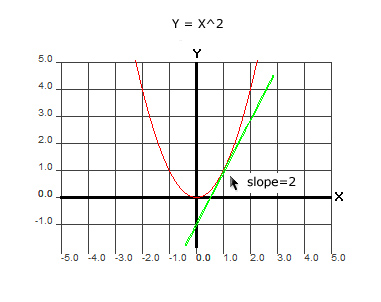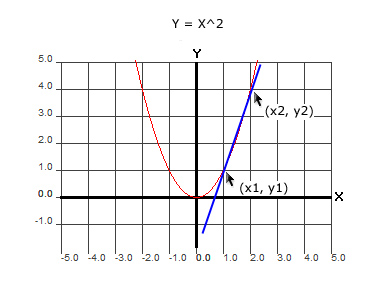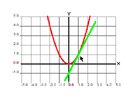Many people are familiar with the basic technique for taking the derivative of a term of a polynomial: you take the exponent, and move it down as a multiplicative factor, and reduce the exponent by 1. For instance, the derivative for x2 is 2x; the derivative for x3 is 3x2; the derivative for x4 is 4x3, etc. This technique is covered in the first semester of calculus. It’s hard to say why this technique works though.
To understand the basis of the technique, it helps to fall back onto the graphical definition of a derivative: it’s the slope of the line tangent to the curve. Let’s look at the y=x2 curve. The green line below in the picture below represents the line tangent to the curve at x=1. We’re interested in the slope of that line. Just by eye-balling it, we can see that the slope is 2 — as we move from the point (1, 1) to (2, 3) we see that as we move to the right one unit, we need to move up two units to stay on the line.

But outside of eye-balling it, how do we know that the slope is 2? And how would we know the slope of the tangent line at other points along the y=x2 curve? What we do is we draw a secant line instead. This is a line that intersects the curve at two points. The blue line in the graph below is a secant line, intersecting the curve at the points (x1, y1) and (x2, y2).

Now if we choose the point (x2, y2) that is really, really close to (x1, y1), the secant line will look very much like the tangent line. In fact, if we move (x2, y2) along the curve until there is absolutely no difference between (x1, y1) and (x2, y2), then we end up with the tangent line itself.
So, our technique for finding the slope of the tangent line will be to find the slope of the secant line, and move the two points of the secant line together until there is no difference between them. We’ll use generic points (x1, y1) and (x2, y2) so that we end up with a formula for the slope of the tangent line, no matter what x or y equals.
The slope (represented by the variable "m") of a line that goes through (x1, y1) and (x2, 2) is calculated as:
![]()
Let’s substitute x2 for y in that formula since we know that both points occur along the y=x2 curve. This substitution gives us:
![]()
We can factor the numerator to give us:

and by canceling (x2 – x1) in the numerator and denominator, we are left with (x2 + x1). We will then move x2 very, very close to x1. We take the limit as x2 approaches x1 and get:
![]()
which equals 2x1. What this tells us is that the slope of a line tangent to the y=x2 curve at (x1, y1) is 2x1. More generally, the slope of the line tangent to y=x2 can simply be calculated as 2x; 2x is the derivative of y=x2.
We’ve seen how this approach can give us the derivative of the y=x2 curve. But how about x raised to other powers? Does this same technique work?
If we take the same approach we will end up with a formula for m where we have substituted xn for y:
![]()
We would like to be able to factor out (x2 – x1) from the numerator. Can we do this for all values of n? Let’s examine n=3, n=4, and n=5, and see if we can factor an (x2 – x1) out of (x2n – x1n). We’ll use a and b instead of x1 and x2 to make things more readable.
With n=3:
(a3 – b3) = (a – b)(a2 + ab + b2)
With n=4:
(a4 – b4) = (a – b)(a3 + a2b + ab2 + b3)
With n=5:
(a5 – b5) = (a – b)(a4 + a3b + a2b2 + ab3 + b4)
It looks like it works. In general, we can say that (an – bn) can be factored as:
| (an – bn) = (a – b) |  |
That notation can be a bit confusing, but essentially if the exponent is n, we’ll have a polynomial coming out of the sum on the right, where in each term the exponent of a decreases from n-1 to 0 and the exponent of b increases from 0 to n-1. For example, in the case of n=4, we saw how we had a polynomial with four parts. The exponent of a started at 3 and decreased to 0. The exponent of b started at 0 and increased to 3.
How does all this help us?
It means that we will always be able to factor out (x – y) from the numerator of our slope equation, and that it will always cancel out of that denominator of (x – y). We are left with that polynomial represented by the sum.
That sum represents the slope of our secant line. To find the slope of the tangent line, we take the limit as b approaches a.

If we substitute a for b, we see that each term of the polynomial will be of the form an-1-mam which equals an-1. There will be n such terms. Therefore, as b approaches a, the sum will equal nan-1.
Let’s summarize where we are.
We are trying to find a general approach to finding a derivative of a formula, which is equivalent to finding the slope of the line that is tangent to the curve described by that formula. We pick two arbitrary points (x1, y1) and (x2, y2). We use the general formula for slope, where we have substituted xn for y:
![]()
and then show that we can always get rid of the denominator by factoring (x2 – x1) out of the numerator.After we do this, are left with the remaining part of the numerator, which we represent as the sum:

As x2 approaches x1, we get a slope equal to nxn-1. This was what we were trying to prove: that we can find the slope of a tangent line (i.e., the derivative of the formula describing the curve) by bringing the exponent down to be a multiplying factor, and just reduce the exponent by 1.
If we represent the derivative of y as y’, then we say that if y = xn then y’ = nxn-1.

